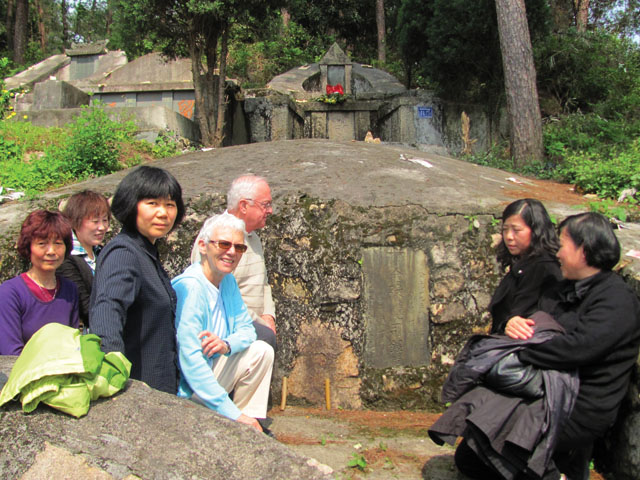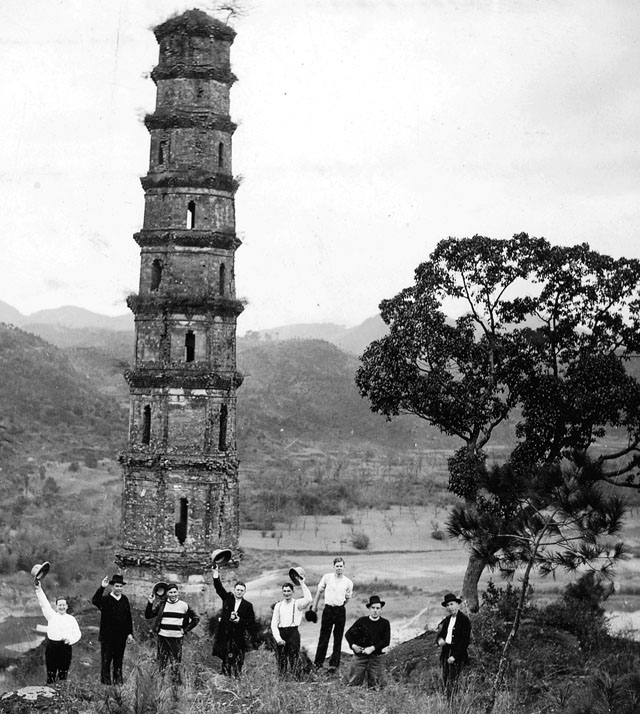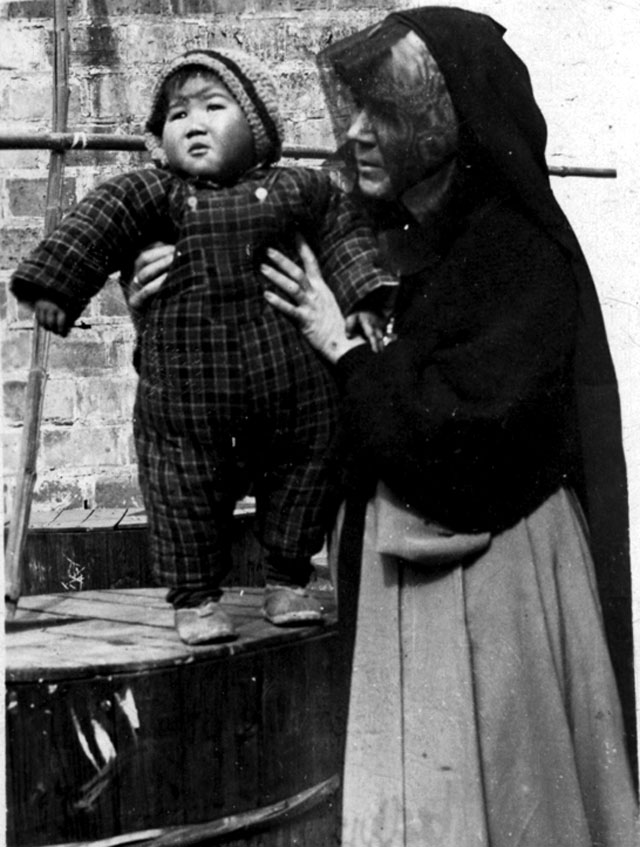Surprised by the Spirit
By Fr. Mike Traher, S.F.M.
September/October 2013
Return to Table of Contents
Print Article
When I was a boy, two Scarboro priests visited our grade six class at St. Joseph’s School in London, Ontario. En route to their first mission assignments, they invited us to support the work of their mission Society by buying a subscription to Scarboro Missions magazine. We were fascinated by their readiness to go out to the world to share the Good News of God’s love. I began reading their magazine, which included stories of the original Scarboro missionaries who had served among the people of Lishui, China, particularly Monsignor John Mary Fraser, their Society’s founder. Never did I dream that one day I would visit Lishui as a Scarboro priest.
Formerly known as Chuchow prefecture, in the early 20th century the name was changed to Lishui, meaning “beautiful waters,” after the graceful river flowing through the city and area. The new Canadian priests and sisters nurtured the seeds of faith originally planted by European missionaries, producing much fruit throughout the area. Their work came to an end when the Communist government came to power in 1949 and China was closed to all foreign missionaries. Only in recent decades have a few of our missionaries managed to visit Lishui again, to the place of our Society’s beginnings.
The Dragon at Close Range
Two years ago, I received an email from a university professor by the name of Renying in Lishui, China, asking for photos of Scarboro’s Monsignor William McGrath, author of the book, The Dragon at Close Range, published in 1935. A gifted writer and observer, Monsignor McGrath had written an interesting and informative description of the people and culture of Chuchow Prefecture. Almost forgotten here at home, the book was rediscovered by Zhou Lu, a young man in Lishui with a passion for history. While browsing the Internet he stumbled upon this treasure and immediately ordered two copies. Apparently very little recorded history exists about Lishui during the first half of the 20th century.
 L-R: Historian Zhou Lu, English professor Renying and Fr. Mike Traher at the Lishui pagoda, the same pagoda as shown on the facing page. In the 1930s the first wave of Scarboro missionaries arrived in the city of Lishui (formerly Chuchow prefecture) in the province of Chekiang (Zhejiang), China. Fr. Mike writes, “Perhaps a thousand years old, this ancient landmark is perched on top of a large hill overlooking the Lishui River where the river divides into two branches. When returning from their mission stations, the early Scarboro missionaries looked for the familiar pagoda to know that they were almost home.”
L-R: Historian Zhou Lu, English professor Renying and Fr. Mike Traher at the Lishui pagoda, the same pagoda as shown on the facing page. In the 1930s the first wave of Scarboro missionaries arrived in the city of Lishui (formerly Chuchow prefecture) in the province of Chekiang (Zhejiang), China. Fr. Mike writes, “Perhaps a thousand years old, this ancient landmark is perched on top of a large hill overlooking the Lishui River where the river divides into two branches. When returning from their mission stations, the early Scarboro missionaries looked for the familiar pagoda to know that they were almost home.”
Zhou Lu placed an ad in the local newspaper asking for help in translating the book into Chinese. The ad was answered by Renying, a university professor of English, who volunteered to help with the project.
Renying and I continued to correspond while the book was being translated. She also asked if we could send a selection of the book’s photos depicting the daily life of the people of Lishui at that time. Among them were pictures of Scarboro priests and also of the Grey Sisters of Pembroke, Ontario, who served the people through medical clinics, caring for orphan children, and visiting the sick.
With the translation completed, Zhou Lu and Renying applied for and received a China government grant to publish their book. By that time, I was well into my sabbatical after 27 years of vocational ministry in Canada and serving on Scarboro’s General Council.
I asked Renying if it was possible for me to come to Lishui for a visit. She agreed to welcome me and even offered to connect me with the local Catholic community. I invited Louise Malnachuk to accompany me. As a Scarboro missioner Louise taught English in China for many years and was fluent in Mandarin.
Arriving in Lishui
Renying met us at the bus station accompanied by Ms. Mei, the lay leader of Lishui’s Catholic church committee. After dropping off our luggage at the hotel, we were taken to see their new church. Still under construction, it is scheduled to be finished in a year’s time and will be surrounded by a scenic park also under development. Lishui has been designated a tourist destination and has benefitted from government-sponsored projects to beautify the city. Our hosts pointed out the area a short distance away where the original church, priests’ house and sisters’ convent had been located overlooking the beautiful Lishui River.
When we met Zhou, the history buff who initiated the translation of The Dragon at Close Range, he informed us that he had arranged for the large quantity of photos we sent him to be displayed in the Lishui Historical Museum down the street from the new church. The exhibit was scheduled to open just after we returned to Canada.
On Sunday we attended the 9:30 a.m. Mass, celebrated in Mandarin, and were welcomed by the lay leaders and Fr. Paul Ma, the pastor. Sacred Heart Parish does not have a resident priest, so each Sunday Fr. Ma comes from the city of Wenzhou, an hour away, to celebrate Eucharist with the community. Inside the church was a picture of Scarboro missionary Kenneth Turner, appointed the first bishop of Lishui in 1948.
The pastoral care of Chuchow Prefecture had been assigned to Monsignor Fraser and his young China Mission Seminary by the bishop of Hangzhou in 1926. Today, as a gesture of friendship reconnecting Scarboro to the Catholic community of Lishui, we presented Fr. Ma with a framed picture of Monsignor Fraser. He intimated that Scarboro Missions would receive an invitation to attend the formal opening of the new parish church next year. Louise and I felt like family coming home for a visit after being away for a long time.
After lunch with Fr. Ma and the parish committee, the lay leaders invited us to visit the graves of Scarboro missionaries Frs. James MacGillvray and Aaron Gignac located on a hillside on the edge of town. Fr. James died in 1935 and Fr. Aaron in 1940. Mr. Li, whose father had worked with these missionaries, explained that it was his responsibility to care for the gravesites of these two servants of God, which he saw as a great honour. Everything about the site spoke of his dedication.
Walking in the footsteps of Scarboro’s early missionaries to Lishui, China, and finding friendship and faith
That evening we were invited to dinner with Mr. Li’s family and the occasion was filled with laughter and stories. In their day, our China missionaries would no doubt have experienced the same Chinese hospitality.
 Members of the Catholic community in Lishui accompany lay missioner Louise Malnachuk and Fr. Mike Traher at the grave of Fr. Paul Kam (photo above left), the first seminarian of the China Mission Seminary (precursor to Scarboro Missions).
Members of the Catholic community in Lishui accompany lay missioner Louise Malnachuk and Fr. Mike Traher at the grave of Fr. Paul Kam (photo above left), the first seminarian of the China Mission Seminary (precursor to Scarboro Missions).
The next day, after an early breakfast of rice porridge, steamed dumplings, and a “boiled tea egg,” we were met by Srs. Zhang and Yu who serve the Catholic communities connected to Lishui. Together with Ms. Mei of the parish committee we drove to the smaller city of Qingtian, south of Lishui, where we caught sight of the majestic profile of the local Catholic Church, Our Lady of the Immaculate Conception.
Sister Gua, the youngest member of the community of sisters, does pastoral ministry among the 50 seniors living in the parish, as well as catechetical ministry and home visits to parishioners. Over a glass of tea, they shared memories of the Scarboro priests, including Fr. Paul Kam who was buried nearby. They enjoyed seeing our photos of Fr. Kam, the first seminarian of the China Mission Seminary (precursor to Scarboro Missions) founded in 1918 by Fr. Fraser in Almonte, Ontario.
After his ordination in 1925, Fr. Kam returned to China with Fr. Fraser to serve among the people. After the Communist government came to power, Fr. Kam was imprisoned and our Society lost all contact with him. The parish leaders told us the rest of his story. Released from prison in 1958 after six years of harsh confinement, he was never able to recover. He returned to the parish house and lived almost as a recluse until his death a few months later. One of the senior residents told us that he cared for Fr. Kam as best he could until he died. This man was delighted to be reconnected with Scarboro missionaries after so many years and asked for a blessing, which I felt privileged to offer him and his family.
 In the village of Bihu, elders look at historical photos on Fr. Mike’s iPad, recognizing some of the Scarboro priests and Grey Sisters they knew as children.
In the village of Bihu, elders look at historical photos on Fr. Mike’s iPad, recognizing some of the Scarboro priests and Grey Sisters they knew as children.
During lunch in the parish rectory we were told stories about the history of the parish and the work of the Scarboro priests and Grey Sisters. We were then taken along winding streets and up the far side of a large hill to Fr. Kam’s grave. As we gathered to pray at his burial site, I thought of the agony he endured alone during his years of imprisonment, and the decades during which our Society had no news of him and knew nothing of his whereabouts. It was not until 2005 that Scarboro missioners Fr. Jack Lynch and Cynthia Chu visited Lishui and by chance learned of his gravesite and were taken to see it.
While driving back from Qingtian to Lishui, the sisters stopped at the farming village of Da Lu, a mission station once served by Scarboro priests. The village elders welcomed us warmly. The news of our surprise visit soon drew a small group of Catholics who proudly showed us their newly renovated church, St. Theresa of the Little Flower, which had originally been built by Scarboro priests. On my iPad, I showed them a photo of the original church when it was just built in 1936, along with other historical photos. They recognized the faces of a few Scarboro priests and Grey Sisters they knew as children, among them Sister St. Angela and Sister Genevieve. They were happy to know that one of the sisters, Sister Susan Daley who served in the town of Lungchuan from 1947 to 1951, was still alive and residing with her community in Pembroke, Ontario.
The next day, the sisters drove us to the village of Bihu, another mission station served by Scarboro priests. The people there eagerly awaited us with a tasty meal of meat and fish, complemented by vegetables and fresh fruit from their gardens. They showed us their newly renovated Canadian Martyrs church and the treasured church bell brought from Canada by the missionaries. The could not remember the name of the Canadian priest who built their church and parish house in 1933, only that he was quite tall. Inside the church, the sisters led everyone in a prayer and in singing of a familiar hymn in thanksgiving for our mutual roots in faith.
The Grey Sisters’ presence
This little group also looked at my iPad collection of historical photos. One of them recognized Sister Catherine who had taken care of him when he was sick as a child. Another remembered Sister St. Angela as very kind, and picked out Sister Juletta, the superior of the community, who had a reputation for being very strict. We also learned about the Grey Sisters’ medical clinic and hospital in Lungchuan where they often treated several hundred patients a day. The impact of the sisters’ medical care, education of the children, and their solicitude for orphaned children are remembered and revered.
“As we gathered to pray at his burial site, I thought of the agony he endured alone during his years of imprisonment, and the decades during which our Society had no news of him and knew nothing of his whereabouts.”
The people of both Da Lu and Bihu reminded me of the biblical anawim, God’s little ones. As more memories bubbled forth, we heard of the suffering their parents endured during the coun-try’s transition to a Communist government in the early 1950s. Some of their fathers were punished and received harsh treatment from the soldiers for having worked with the foreign priests and sisters as catechists, drivers, and cooks. Yet, here were the children of these parents, holding steadfast in their faith and optimism about the future of their joy-filled faith communities. Their strength and determination continues to keep them together as communities focused on Christ their Shepherd.
As we drove back to Lishui, I was beginning to feel the weight of history making itself present. We had stood among the descendants of people who so inspired Monsignor Fraser and his priests to live in a strange land, adapt to a new culture, and struggle to learn the local Chinese dialect and customs. The Canadian priests and sisters had worked to build up the local Church, to convey the faith as best they could, to love and be loved by the people, to endure together with them the violence of World War II, followed by a civil war, and finally to be expelled from their mission never to return. Such however is the price they willingly paid to answer the call of Christ and his mission among the people of China.
On our last morning, our hosts arrived to see us to the bus station. With typical Chinese hospitality, they gave us fruit for the journey, lest we get hungry along the way. At the station while gathered around us to say goodbye, the little group asked for a blessing. As I quietly offered the blessing, I realized how fitting a way this was to conclude our visit. We had arrived as strangers and were leaving as friends and members of the extended Catholic family of Lishui, a family whose faith was nurtured by Scarboro priests and Grey Sisters all those years ago. I could only marvel again at how this came to be, through a nearly forgotten book written by a Canadian missionary priest and discovered by a young man in Lishui, China, with a passion for history. The whole experience was truly one of being surprised by the Spirit.
Fr. Mike Traher is now missioned to Guyana.
Return to Table of Contents
Print Article



